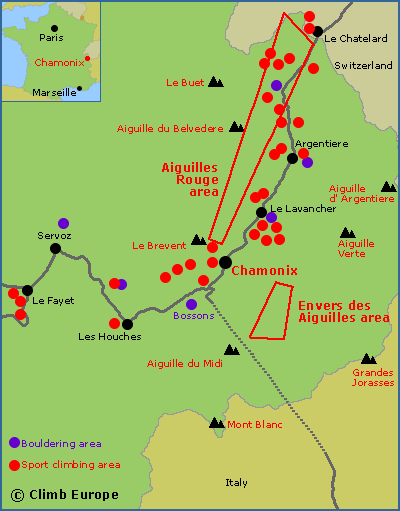Rock climbing and mountaineering around Chamonix
Chamonix is a world-class area for mountaineering and rock climbing that is famous all over the world. Dominating Chamonix is Mont Blanc, the highest mountain in Western Europe at 4,810m. The Mont Blanc Massif is home to 27 peaks over 4,000m that offers an abundance of long alpine routes on granite rock. The 4,000m Peaks of the Alps Guidebook, Volume 1 West, describes classic routes up all of these 4,000m peaks in the Mont Blanc Massif.
Map of the main rock climbing areas in Chamonix

Long multi-pitch rock climbing in Chamonix
However, it is the huge granite towers and spikes to the left of the Aiguille de Midi (looking from Chamonix) that offer the classic Alpine rock climbing the area is also famous for. These towers and spikes generally finish at an altitude of over 3,000m, with routes typically from a few hundred metres to around 1,000m long. Starting from Chamonix many of these routes will usually take more than a day to complete requiring an overnight stay at either the Requin hut or the Envers des Aiguilles hut. Other routes are more easily accessible from the Montenvers Railway or the Aiguille du Midi telepherique. To get to the base of the routes it is essential to be comfortable in moving over glaciers. The guidebook describing this area is called Mont Blanc Granite – Chamonix Aiguilles, which describes many multi-pitch routes and is available to buy from our shop. The climbing described in this guidebook is across all grade ranges though it always feels more difficult at altitude.
On the opposite side of the valley to Mont Blanc are the Aiguilles Rouge Mountains that range from Le Brevent and beyond the Aiguille du Belvedere to Remua. These reddish gneiss rock walls are at a lower altitude than the main Mont Blanc massif and are also more accessible from Chamonix via a series of ski lifts or nearby car parks. This easy access means that the majority of the routes can be completed in a single day from Chamonix. The routes here are long multi-pitch ones that are often several hundred metres long, with the style of climbing a mixture of fully bolted routes through to pure traditional routes. Many of these routes in this area are covered in the Rockfax Chamonix rock climbing guidebook and the Aiguilles Rouge 2 guidebook.
Sport climbing around Chamonix
Running from Le Fayet all the way to Switzerland are a series of valley crags offering good sport climbing. These are free of snow from May onwards and give a good mixture of single and multi-pitch sports routes across a wide range of grades. The type of rock is a mixture between granular gneiss and granite. These crags are at various altitudes from a few hundred metres to over 2000m giving plenty of choice depending on how hot it is or the time of year.
There is a guidebook covering all the sport routes in the Chamonix valley called Crag Climbs in Chamonix and it covers 35 separate crags in this area. Buy this guidebook from our shop.
Bouldering around Chamonix
There are also some excellent bouldering areas in the Chamonix valley including some circuits (Fontainebleau style) and countless isolated problems. The bouldering around Chamonix offers different types of rock from; rough high mountain limestone at Le Col de la Colombiere; granite at Les Bossons and Le Lavancher; and gneiss at the excellent Medonnet area. These bouldering areas are at a variety of altitudes and some areas are sheltered in the trees, which mean it is possible to boulder whatever the temperature as long as it is dry and free of snow.
The definitive guidebook covering the bouldering around Chamonix is called “Les Blocs de la region de Chamonix”. It details over 1,000 problems in 19 different area, across a wide range of grades. The Crag Climbs in Chamonix Guidebook also covers 4 different bouldering areas, including Les Bossons, Moraine and Col des Montets. Buy these guidebooks from our shop.
Chamonix Logistics
Due to the high altitude of Chamonix, it is only in the summer months when the area is largely snow free. This coupled with the longer days mean it is the best time to visit for the long multi-pitch routes particularly on the Aiguilles de Chamonix side. However on the Aiguilles Rouge side it is possible to climb later into the autumn due to the lower altitude and easy access.
There are various rock climbing guidebooks covering the Chamonix area that are available to buy from our shop. The Rockfax Chamonix rock climbing guidebook describes the very best rock climbs and mountain routes around Chamonix and Mont Blanc. It covers everything from topping out on Mont Blanc, spectacular peaks and spires, classic long ridges, to intimidating north faces and valley sport climbing.
Chamonix is also a great place to go walking and mountaineering as well as rock climbing. IGN produce an excellent range of 1:25,000 maps that cover the whole of France (blue cover). The 3630 OT - Chamonix/Massif du Mont Blanc Walking Map covers Mont Blanc peak and the whole of the Chamonix Valley, whilst the 3531 ET - St-Gervais-Les-Bains/Massif du Mont Blanc Walking Map covers the whole of the Mont Blanc massif with the actual Mont Blanc peak in the middle of the map.